

New Facebook guidelines require news and video apps to wait at least 10 seconds before publishing user activity. New Facebook guidelines require news and video apps to wait at least 10 seconds before publishing user activity Facebook has updated its Open Graph publishing guidelines to require social news and video apps to wait at least 10 seconds before posting “read” or “watch” actions to a user’s Timeline.
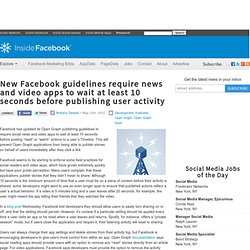
This will prevent Open Graph applications from being able to publish stories on behalf of users immediately after they click a link. Facebook seems to be starting to enforce some best practices for social readers and video apps, which have grown extremely quickly but have poor public perception. Many users complain that these applications publish stories that they didn’t mean to share. Although 10 seconds is the minimum amount of time that a user must be on a piece of content before their activity is shared, some developers might want to use an even longer span to ensure that published actions reflect a user’s actual behavior. Sponsored Post Hands-On Social Media Training for Beginners.
Facebook is Getting Crowded: 12 Media Apps Join Timeline. Facebook social reader app contributes to record traffic for U.K. news site. The Guardian reached a new record of unique visitors and page impressions for Guardian.co.uk in February, and the news organization attributes 30 percent of referral traffic to Facebook.
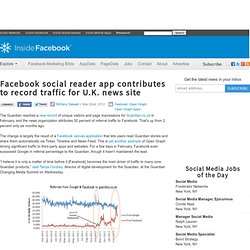
That’s up from 2 percent only six months ago. The change is largely the result of a Facebook canvas application that lets users read Guardian stories and share them automatically via Ticker, Timeline and News Feed. This is yet another example of Open Graph driving significant traffic to third-party apps and websites. For a few days in February, Facebook even surpassed Google in referral percentage to the Guardian, though it hasn’t maintained the lead. “I believe it is only a matter of time before it [Facebook] becomes the main driver of traffic to many core Guardian products,” said Tanya Cordrey, director of digital development for the Guardian, at the Guardian Changing Media Summit on Wednesday.
Cordrey also discussed statistics and trends related to the company’s social news app. Facebook tests new way to let users know which links come from social readers and whether their activity will be shared. Facebook tests ‘trending articles’ feature to encourage users to try social reader apps. Facebook tests ‘trending articles’ feature to encourage users to try social reader apps Facebook appears to be testing new feature to highlight social reader articles within users’ News Feeds.
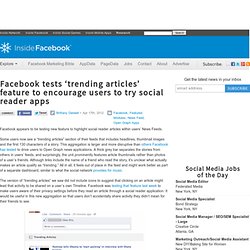
Some users now see a “trending articles” section of their feeds that includes headlines, thumbnail images and the first 130 characters of a story. This aggregation is larger and more disruptive than others Facebook has tested to drive users to Open Graph news applications. A thick grey bar separates the stories from others in users’ feeds, and surprisingly, the unit prominently features article thumbnails rather than photos of a user’s friends. Why Facebook Social Reading Apps Don't Work. Facebook has begun showing some users a "Trending Articles" section right inside their news feeds, whether they want it or not.
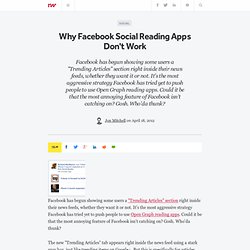
It's the most aggressive strategy Facebook has tried yet to push people to use Open Graph reading apps. Could it be that the most annoying feature of Facebook isn't catching on? Decline Of Reader Apps Likely Due To News Feed Changes, Shows Facebook Controls The Traffic Faucet. No, Facebook news reader apps aren’t declining because users suddenly got fed up with auto-sharing.
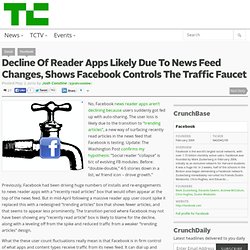
The user loss is likely due to the transition to “trending articles”, a new way of surfacing recently read articles in the news feed that Facebook is testing. Update: The Washington Post confirms my hypothesis: “Social reader “collapse” is b/c of evolving FB modules. Before: “double-double,” 4-5 stories down in a list, w/ friend icon – drove growth.” Previously, Facebook had been driving huge numbers of installs and re-engagements to news reader apps with a “recently read articles” box that would often appear at the top of the news feed.
But in mid-April following a massive reader app user count spike it replaced this with a redesigned “trending articles” box that shows fewer articles, and that seems to appear less prominently. What the these user count fluctuations really mean is that Facebook is in firm control of what apps and content types receive traffic from its news feed. Data shows social readers have mixed results, but aren’t ‘collapsing’ Despite reports that social readers are “all collapsing,” an analysis of monthly and daily active users of Facebook-integrated social news applications shows no clear trends in growth or decline across the board.

We looked at 12 media sites and apps that integrate Open Graph to allow users to automatically share their reading and viewing activity with friends, and have concluded there is no single trend affecting these apps the same way. The Huffington Post‘s web and mobile integration, for example, continues to steadily gain new monthly active users. The Washington Post Social Reader, a canvas application with a mobile component, has seen a decline over the past month. Yahoo‘s web and mobile integration has seen a dip in MAU recently, but it has more than doubled its usage since March to become the app with the more MAU than any other built on the Facebook platform.